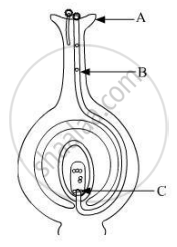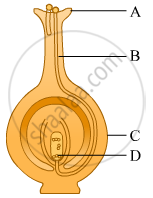Advertisements
Advertisements
प्रश्न
What are the agents for pollination?
उत्तर
Pollination occurs with the help of abiotic agents (wind, water) and biotic agents (insects and other animals).
APPEARS IN
संबंधित प्रश्न
Name the parts A, B and C shown in the diagram and write their functions.

The anther contains ______.
A flower may have either male or female reproductive parts. Such a flower is called ______.
Mature ovary forms the ______.
Draw a neat sketch of the stamen of a flower. Mark in it filament and anther.
How do the insects help in cross-pollination?
What type of plants reproduce by sexual reproduction method?
Describe the process of fertilisation in a flower with the help of labelled diagrams.
What changes take place in the flower after fertilisation which lead to the formation of seeds and fruit?
In the figure given alongside, the parts marked A, B and C are sequentially :
(a) cotyledon, plumule and radicle
(b) plumule, radicle and cotyledon
(c) plumule, cotyledon and radicle
(d) radicle, cotyledon and plumule
In a bisexual flower, inspite of the young stamens being removed artificially, the flower produces fruit. Explain.
In what ways is fertilisation in a plant similar to fertilisation in a human?
Put a tick mark (✓) against the correct alternative in the following statement
Reproductive whorls of a flower are:
What is a flower ? Draw a neat labelled diagram showing the L.S. of a typical flower.
Identify A, B, C and D in the given diagram and write their names.
A student is asked to study the different parts of an embryo of pea seeds. Given below are the essential steps for the experiment :
(I) Soak the pea seeds in plain water and keep them overnight.
(II) Cut open the soaked seed and observe its different parts.
(III) Take some pea seeds in a petri dish.
(IV) Drain the excess water. Cover the seeds with a wet cotton cloth and leave them as it is for a day.
The correct sequence of these steps is
(A) III, I, IV, II
(B) III, IV, I, II
(C) III, I, II, IV
(D) III, II, I, IV
Draw a diagram of the longitudinal section of a flower and label on it sepal, petal, ovary and stigma.
Write the names of male and female reproductive parts of a flower.
List any two differences between pollination and fertilisation.
Sketch the labeled diagram:
Flower with its sexual reproductive organs
Prepare a slogan for campaign against female foeticide.
Draw a diagram of the longitudinal section of a flower and label the following parts.
Find the odd one out:
__________ is present in unisexual flower.
Find an odd one out.
Bisexual : Hibiscus : : Unisexual : ___________
Define.
Inflorescence
Give scientific reason.
Flower is a structural unit of sexual reproduction in plants.
Explain the sexual reproduction process in plants with a diagram.
The anther wall consists of four wall layers where ______
The ovule of an angiosperm is technically equivalent to ______
Identify the female gametophyte in angiosperms.
Pineapple fruit develops from ______.
What would be the number of chromosomes in the cells of the aleurone layer in a plant species with 8 chromosomes in its synergids?
The seed that contains the future plant is called the ______
Variations occur as a result of ______
Complete the table
| Carly x | ______ | ______ |
| ______ | petal | attract insects |
| Androecium | ______ | Male reproductive part |
| ______ | ______ | Female reproductive part. |
Give reason for the following:
Fertilization cannot take place in flowers if pollination does not occur.
Where is the zygote located in the flower after fertilization?
The ovaries of different flowers may contain
